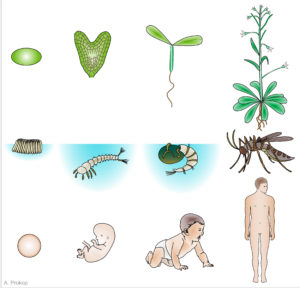 The BSDB recently initiated an advocacy campaign, starting with (1) the gradual development of the best arguments providing elevator pitches to be used in discussions, presentations, applications or publications, and (2) the collation of support resources which were first published on the BSDB website and are now present in improved version on The Node. To take this initiative a step further, I recently took an invitation by the journal Open Access Government as an incentive to write a short text that would explain the nature as well as the societal importance and impact of DB in terms that are understandable to lay audiences. Please, read the outcome of that effort here. Please note that this is only a first attempt, but I hope that it will serve as a template that can be used and further developed by members of the DB community.
The BSDB recently initiated an advocacy campaign, starting with (1) the gradual development of the best arguments providing elevator pitches to be used in discussions, presentations, applications or publications, and (2) the collation of support resources which were first published on the BSDB website and are now present in improved version on The Node. To take this initiative a step further, I recently took an invitation by the journal Open Access Government as an incentive to write a short text that would explain the nature as well as the societal importance and impact of DB in terms that are understandable to lay audiences. Please, read the outcome of that effort here. Please note that this is only a first attempt, but I hope that it will serve as a template that can be used and further developed by members of the DB community.
All posts by comms
Report: Joint BSBD/Nordic Autumn Meeting
Joint BSDB/Nordic Conference on Developmental Biology and Regeneration
The Joint BSDB/Nordic Conference on Developmental Biology ad Regeneration was first proposed to SWEDBO and FSDB in December 2014, so had been in planning for almost three years. It was organised by Megan Davey (BSDB), Joe Rainger (Univ. Edinburgh), Elke Ober and Palle Serup (Denmark), Satu Kuure (FSDB), Luiza Ghila and Helge Raeder (Norway), Christos Samakovlis, Andreas Simon and Sara Wilson (SWEDBO). Particular thanks go to Sara Wilson, Andreas Simon and their ground support, Paulina Pettersson, for their hard work and organisation, and to Joe Rainger who drove the sponsorship. Thanks also to the BSDB members who travelled to Sweden for the meeting and Thomas Jessell who could be persuaded to travel all the way from New York for his plenary session. I strongly feel that the meeting was an outstanding success
Attendance – With volunteers and sponsor attendees we had a total of 212 attendants, of which 194 were registered scientific attendees, 15 were invited speakers, and 22 were BSDB members (8 being supported by travel grants). Other than UK attendees, Sweden (understandably) had the most attendees (94) but there was also a strong showing from Denmark, Finland and China. We additionally had attendees from Austria, Ireland, Brazil, Norway, Spain, Czech Republic and USA.
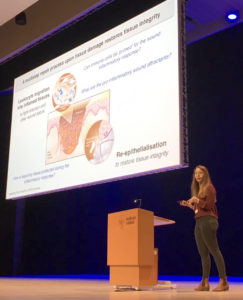 Program – We aimed to have a general scientific program covering all aspects of Developmental Biology in plants, invertebrates and vertebrates. With Tom Jessell (Columbia University, NY. USA) as our EMBO-sponsored plenary, there was a strong emphasis on nervous system development (Session 1 -13 talks), which included development of motor circuits, visual circuits, enteric nervous system, regeneration, neural crest, evolution and single cell transcriptomics. Highlights of this session were Tom’s superb talk who explained how they pick apart the identity and function of interneurons, and the presentation by Igor Adameyko (Karolinska Institute, Sweden) about single cell transcriptomics in neural crest development. Session 2 (15 talks) was on organogenesis & morphogenesis and covered mathematical modelling of development, mammalian blastocyst, pancreas, heart and kidney development, and vertebrate genetics. A particular highlight was Leif Andersson’s (Uppsala University, Sweden) talk who illustrated wonderfully how structural genomic changes contribute to dramatic
Program – We aimed to have a general scientific program covering all aspects of Developmental Biology in plants, invertebrates and vertebrates. With Tom Jessell (Columbia University, NY. USA) as our EMBO-sponsored plenary, there was a strong emphasis on nervous system development (Session 1 -13 talks), which included development of motor circuits, visual circuits, enteric nervous system, regeneration, neural crest, evolution and single cell transcriptomics. Highlights of this session were Tom’s superb talk who explained how they pick apart the identity and function of interneurons, and the presentation by Igor Adameyko (Karolinska Institute, Sweden) about single cell transcriptomics in neural crest development. Session 2 (15 talks) was on organogenesis & morphogenesis and covered mathematical modelling of development, mammalian blastocyst, pancreas, heart and kidney development, and vertebrate genetics. A particular highlight was Leif Andersson’s (Uppsala University, Sweden) talk who illustrated wonderfully how structural genomic changes contribute to dramatic 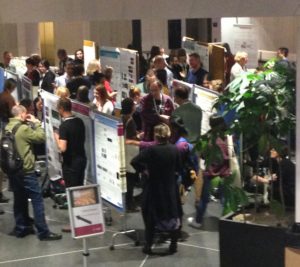 phenotypic evolution in birds, with particular emphasis on behaviour and plumages. Session 3 (8 talks) was on stem cells & regeneration which included a huge variety of science, including the role of forces in developing stem cell niches, regeneration in salamanders, skeletal muscle, tissue repair and regeneration and organisation in plants. A highlight was Ari Pekka Mahonen’s presentation who presented his work identifying a core regulatory network within the cambial stem cell niche in Arabidopsis.
phenotypic evolution in birds, with particular emphasis on behaviour and plumages. Session 3 (8 talks) was on stem cells & regeneration which included a huge variety of science, including the role of forces in developing stem cell niches, regeneration in salamanders, skeletal muscle, tissue repair and regeneration and organisation in plants. A highlight was Ari Pekka Mahonen’s presentation who presented his work identifying a core regulatory network within the cambial stem cell niche in Arabidopsis.
We also had two 3hr-long poster sessions with drinks and nibbles. The buzz was really fantastic, attendance was superb and, in fact, we had to ask people to leave at the end of both evenings, so security could close the building.
Prizes – The Swedish society for developmental biology (SWEDBO) gave out three €100 travel grants as poster prizes to Yiqiao Wang (Karolinska Institute, Sweden), Mariane Teradup Pedersen (Univ. Copenhagen, Denmark) and Li Hi (Stockholm University, Sweden). A prize of €200 donated by Scanbur, was awarded to Arvydas Dapnkunas (University of Helsinki, Finland) for his work developing a 3D culture system to explore factors governing the organisation and self-renewal of nephron progenitors. Finally, the BSDB organised the Dennis Summerbell Award Lecture which was given by Helen Weavers on the inflammatory response to tissue damage in Drosophila (see details here).
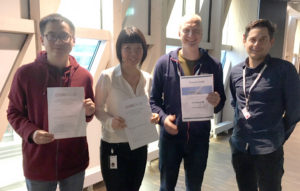
L-R: Poster prize winners Yiqiao Wang, Li Hi, and Arvydas Dapkunas, with organiser Joe Rainger
Venue – What can I say … the Aula Medica at the Karolinska Institute was amazing! Beautiful, beautiful building! Amazing staff! Best AV I’ve experienced ever! Great areas for posters and sponsors! Super comfy chairs! A green room! With showers (just in case…??)! And the best of it all: we could get it at a good price since it was organised internally through the Karolinska Institute.

Sponsorship – Joe Rainger led on the recruitment of sponsors, including designing the different sponsorship rates, contacting sponsors and assisting them on-site, and establishing communication between sponsors, Aula Medica team and conference attendees. The effort the sponsors themselves put in was great. For example, Nikon and Zeiss bought microscopes including a spinning disk confocal from Nikon. Everyone came away really happy, and Aula Medica was very impressed, as were the sponsors.
Megan Davey
Helen Weavers – Dennis Summerbell Awardee 2017
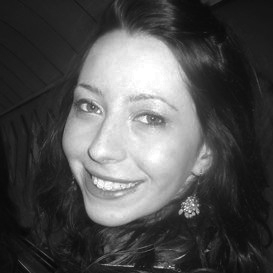 Following a generous donation, the BSDB has instituted the Dennis Summerbell Lecture, to be delivered at its annual Autumn Meeting by a junior researcher at either PhD or Post-doctoral level. The 2017 lecture awardee was Helen Weavers (School of Biochemistry, Faculty of Biomedical Sciences, University of Bristol) with her submitted abstract “Understanding the inflammatory response to tissue damage in Drosophila: a complex interplay of pro-inflammatory attractant signals, developmental priming and tissue cyto-protection”. Her award lecture was presented at the Autumn Meeting 2017, jointly organised by the BSDB together with the Swedish, Finish, Norwegian and Danish Societies of Developmental Biology, 25-27 October 2017 in Stockholm.
Following a generous donation, the BSDB has instituted the Dennis Summerbell Lecture, to be delivered at its annual Autumn Meeting by a junior researcher at either PhD or Post-doctoral level. The 2017 lecture awardee was Helen Weavers (School of Biochemistry, Faculty of Biomedical Sciences, University of Bristol) with her submitted abstract “Understanding the inflammatory response to tissue damage in Drosophila: a complex interplay of pro-inflammatory attractant signals, developmental priming and tissue cyto-protection”. Her award lecture was presented at the Autumn Meeting 2017, jointly organised by the BSDB together with the Swedish, Finish, Norwegian and Danish Societies of Developmental Biology, 25-27 October 2017 in Stockholm.Helen’s work so far
After completing her PhD studies investigating Drosophila nephrogenesis in Helen Skaer’s lab in Cambridge, Helen moved to Bristol in 2013 to take up a 5 year, MRC-funded post-doc position between Paul Martin’s and Will Wood’s labs. Her first publication from this work (Weavers et al., 2016, Cell 165, 1658ff.), showed that Drosophila macrophages (haemocytes), must first be “primed” by engulfing at least one dead cell, before they are responsive to wound attractants. These findings are important because the majority of human pathologies are a consequence of too little or too much inflammation. What really excited the judges of the Denis Summberbell Lecture award was the work which had led to her most recent paper entitled “Systems Analysis of the Dynamic Inflammatory Response to Tissue Damage Reveals Spatiotemporal Properties of the Wound Attractant Gradient” (Weavers et al., 2016, Curr Biol 26, 1974ff.). This was a true multidisciplinary study, using a combined approach of mathematics and biology to analyse macrophage behaviours in response to tissue damage. Although the identity of the wound attractant signal/s are still not clear, this study was able to determine several of the characteristics of the attractant(s). Building on this strong platform of work, Helen is currently developing her own research towards understanding tissue protection/resilience in Drosophila and man, and this was an exciting novel element of her award lecture. In her talk, she described in a stunningly visual and understandable way how successful tissue repair relies not only on the host’s ability to mount an effective inflammatory response, but also on its ability to limit it. Her talk was a fabulous highlight and a shining example of high quality research by members of the BSDB.
Lecture abstract:
 Understanding the inflammatory response to tissue damage in Drosophila: a complex interplay of pro-inflammatory attractant signals, developmental priming and tissue cyto-protection
Understanding the inflammatory response to tissue damage in Drosophila: a complex interplay of pro-inflammatory attractant signals, developmental priming and tissue cyto-protection
Helen Weavers, Bristol, UK
An effective inflammatory response is pivotal to fight infection, clear debris and orchestrate the repair of injured tissues; however, inflammation must be tightly regulated since many human disease pathologies are a consequence of inflammation gone awry. Using a genetically tractable Drosophila model, I use precise genetic manipulation, live imaging and computational modelling to dissect the mechanisms that activate the inflammatory response to tissue damage and those that simultaneously protect the regenerating tissue from immunopathology. Upon tissue damage, immune cells (particularly neutrophils and macrophages) are recruited into the damaged area by damage signals (danger-associated molecular patterns, DAMPs) released from the injured tissue. In collaboration with computational biologists, we employ a sophisticated Bayesian statistical approach to uncover novel details of the pro-inflammatory wound attractants, by analysing the spatio-temporal behaviour of Drosophila immune cells as they respond to wounds. We show that the wound attractant is released by wound edge cells and spreads slowly through the tissue, at rates far slower than small molecule DAMPs such as ATP and H2O2. Strikingly, we also find that immune cells must be developmentally ‘primed’ by uptake of apoptotic corpses before they can respond to these damage attractant signals. Such corpse-induced priming is an example of “innate immune memory” and may serve to amplify the inflammatory response in situations involving excessive cell death – and otherwise limit an overzealous and damaging immune response. Indeed, whilst inflammation is clearly beneficial, toxic molecules (e.g. reactive oxygen species, ROS) generated by immune cells to fight infection, can also cause significant bystander damage to host tissue and delay repair – and may underpin chronic wound-healing pathologies in the clinic. To counter this, I find that wounded Drosophila tissue employs a complex network of cyto-protective pathways that promote tissue ‘resilience’, which both protect against ROS-induced damage and stimulate damage repair. Successful tissue repair, therefore, not only relies on the host’s ability to mount an effective inflammatory response, but also its ability to finely tune it and limit associated immunopathology.
Iwo Kucinski – Dennis Summerbell Lecture awardee 2016
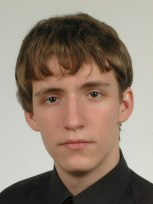 Following a generous donation, the BSDB has instituted the Dennis Summerbell Lecture, to be delivered at its annual Autumn Meeting by a junior researcher at either PhD or Post-doctoral level. The inaugural Dennis Summerbell Lecture was given by Iwo Kucinski at the 2016 BSDB Autumn Meeting. His work was carried out in Eugenia Piddin’s laboratory at the Gurdon Institute, University of Cambridge. The lecture was entitled “The molecular signature of the loser cell status reveals key pathways regulating cell competition”.
Following a generous donation, the BSDB has instituted the Dennis Summerbell Lecture, to be delivered at its annual Autumn Meeting by a junior researcher at either PhD or Post-doctoral level. The inaugural Dennis Summerbell Lecture was given by Iwo Kucinski at the 2016 BSDB Autumn Meeting. His work was carried out in Eugenia Piddin’s laboratory at the Gurdon Institute, University of Cambridge. The lecture was entitled “The molecular signature of the loser cell status reveals key pathways regulating cell competition”.
Abstract:
Cell competition is a process conceptually similar to natural selection at the cellular level. In this process a population of less fit cells (losers) is sacrificed and eliminated by a population of fitter cells (winners), with the ultimate goal of maximising tissue and organism fitness. This mechanism has been proposed to play a role in tissue health and turnover and in disease states such as cancer. Despite its discovery four decades ago and increasing examples of mutations inducing the loser status, the molecular properties that earmark cells as losers have not been identified.We identified molecular differences between winner and loser cells through comparative transcriptomics of two seemingly functionally unrelated mutations, which share the loser phenotype: Minute heterozygous mutations (ribosomal defect) and a mutation in mahj (involved in cell polarity and protein degradation). This revealed a molecular signature composed of a core set of genes that are differentially expressed specifically in loser cells.Through subsequent functional analysis we found that three components of this signature play an important role in controlling proliferation and cell death during cell competition. First, loser cells chronically activate JNK signaling, which restricts their intrinsic growth rate. Secondly, the constitutive activation of JAK/STAT pathway promotes proliferation of loser cells but also nonautonomously fuels the expansion of competing wild-type cells, boosting cell competition. Thirdly, we find that chronic activation of Nrf2 induces the oxidative stress response and that this serves a dual purpose: it promotes survival of loser cells on their own, but it is also sufficient to trigger their elimination when they are confronted by wild-type cells. Altogether these findings provide important new mechanistic insight on how cell competition occurs.
The BSDB’s advocacy strategy
The BSDB’s advocacy strategy
As argued in a recent PLoS Blog, there are alarming indications of communication fatigue in our community which weakens our ability to coordinate our activities and promote the importance of our science. But why do we turn off in this way at the worst possible time when conditions for fundamental research are worsening? As my colleague Sam Illingworth and I have argued in an editorial for a recent special issue about science communication, the likely reasons include (1) lack of awareness about the means and power of communication, (2) lack of incentives and external rewards for participation in science communication, and (3) lack of time: as academics we usually have more than 5 professions rolled into one, and the time demand in each of these professional spheres is steadily increasing, suffocating our productivity as scientists, let alone as communicators.
Notwithstanding, I argued in the above mentioned PLoS Blog that current circumstances cry out for communication and we MUST find feasible and effective ways to do so. As I argued, this is possible through the formation of collaborative networks of science communication. To achieve this, we need to communicate within our own communities to be able to coordinate our action. We need to make our individual contributions to science communication; if we are prepared to share the fruits of our activities, for example via The Node, this can then lead to the cumulative build-up of high quality and freely available resources and strategies. Finally, we need to make active use of and further improve existing resources and strategies; by reaching out jointly we will have a higher chance of gaining momentum and impact – all with the common goal of promoting dialogue about the science we love.
To lead the way in this direction, the BSDB has started an advocacy campaign together with The Node. The first step is simple and consists in putting together the best arguments for Developmental Biology and powerful examples illustrating these statements. The first draft of this document has been published on the BSDB site and on The Node. This resource can now be capitalised on by us all, but it also requires further community input to refine and complement the arguments – in particular also in the areas of Plant Biology and Evo-Devo which are not well represented. To catalyse this process, the editorial team of Development has complementary plans that will be announced in due term, and the BSDB has initiated a writing competition for PhD students and postdocs focussing on advocacy.
The gradually improving advocacy resource is intended to provide us with effective elevator pitches that can be used in dialogue with the public, students, other scientists, clinicians and politicians – and many of the arguments may fly well also on grant applications or in scientific publications. The overarching goal is to achieve wider recognition of fundamental Developmental Biology research as an important science branch that deserves public funding support.
But we should not stop there, and hopefully more members of our community will join in and help to develop creative science communication initiatives that carry dialogue proactively into the relevant target groups. Ideally, this is done through collaboration and long-term objective setting which has a higher chance of achieving sustainability, momentum and impact. To illustrate this point, a recent special issue on science communication describes examples of existing initiatives, explaining their origins and gradual developments. To facilitate the task, the BSDB and The Node have collaborated to put together a link collection (originally published on the BSDB site) which provides ideas, advice and resources that can be used and followed. We hope that these actions taken by the BSDB will help to raise the awareness of and participation in science communication and advocacy within our community for the benefit of all.
Andreas Prokop

